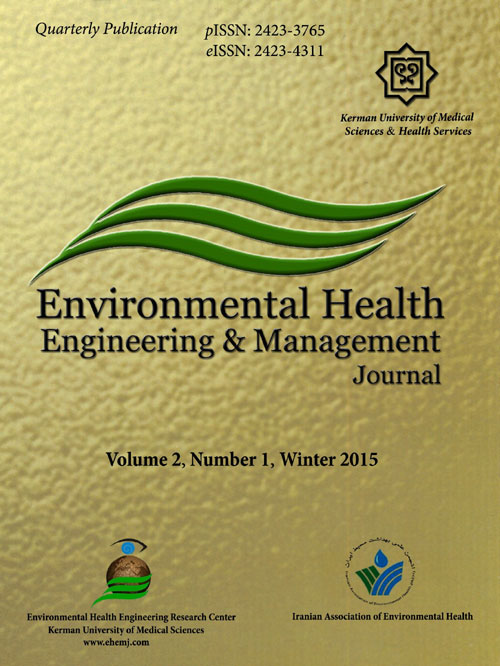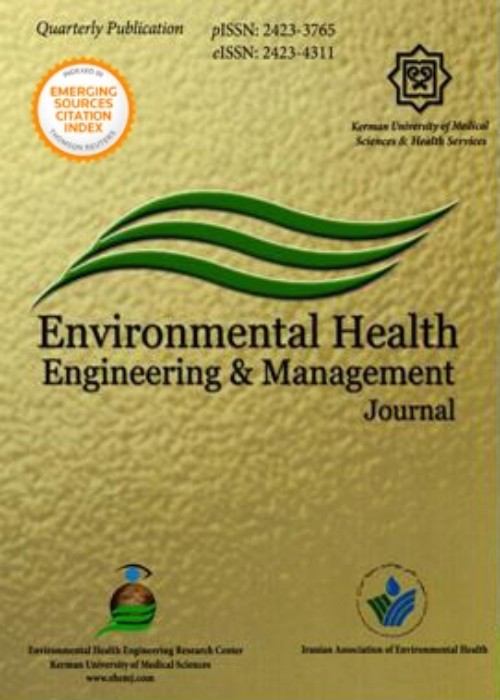فهرست مطالب

Environmental Health Engineering and Management Journal
Volume:2 Issue: 1, Winter 2015
- تاریخ انتشار: 1394/03/03
- تعداد عناوین: 8
-
-
Pages 1-6BackgroundEntry of untreated wastewater of wool scouring factories has been associated with many environmental hazards because of high rate of pollution. Presently effective treatment methods and reducing the costs of operation and maintenance from treatment units have always been under the attention of this industry owners. The aim of this survey is to present a suitable method for the treatment of wool scouring.MethodsIn this study, chemical coagulant is used for wastewater treatment (aluminum sulfate, ferric chloride, poly aluminum chloride and lime). And then these materials with “ozone” as a strong oxidative in reduction of the amount of Chemical Oxygen Demand (COD) in wastewater effluent has been surveyed.ResultsThe results of this work showed that only ferric chloride and aluminum sulfate among the above chemical coagulant had a high efficiency in the turbidity removal. Productivity of turbidity removal using ferric chloride with the pH of 4 to 5 was 99%, and turbidity was reduced from 166 Nephelometric Turbidity Units (NTU) to 1.5 NTU, and productivity of turbidity removal using aluminum sulfate within the pH 4.5 to 5 was 99.33% that reduced turbidity from 166 to 1.1 NTU. Results of ozonation with 5 g/hour and the oxygen flow of 2.5 litter per min with the pH assess of 15, 30, 45, 60, 90, 120, and 150 min to wastewater from chemical treatment with ferric chloride showed that the rate of COD was reduced from 24700 mg/L to 2940 mg/L. In ozonation to wastewater of chemical treatment with aluminum sulfate within the above rang of time, the rate of COD was reduced from 22500 mg/l to 4800 mg/l.ConclusionWe can be hopeful that in near future, getting the cheap technology of ozone production in industrial scale, one can use this technology for the propose of removal of pollutants having removal preferable by help of advanced treatment approaches.Keywords: Industrial wastewater, COD, Wool scouring, Chemical treatment, Ferric chloride, Aluminum sulfate, Ozonation, Turbidity
-
Pages 7-11BackgroundSurvey of pollution and evaluation of water quality in rivers with Oregon Water Quality Index (OWQI) and GIS are effective tools for management of the impact of environmental water resources. The information in calculating the WQI of Moradbeik river allowed us to take our tests results and make a scientific conclusion about the quality of water. GIS can be a powerful tool for developing solutions for water resources problems for assessing water quality, determining water availability, preventing flooding, understanding the natural environment, and managing water resources on a local or regional scale.MethodsThe WQI of Moradbeik river consists of nine tests: Fecal Coliform (FC), Biochemical Oxygen Demand (BOD5), Nitrates (NO3), Total Phosphate (PO4), pH, temperature, Dissolved Oxygen (DO), turbidity, and Total Solid (TS). Water quality of Moradbeik river was investigated for 12 months. Concentrations of these nine variables were normalized on a scale from 0 to 100 and translated into statements of water quality (excellent, good, regular, fair, and poor). Also this data were analyzed with WQI index, and then river basis on water quality was zoning by GIS.ResultsThe average of WQI was 61.62, which corresponded to ‘‘medium’’ quality water at the sampling point 1 (best station) and decreased to around 26.41 (bad quality) at sampling point 6. The association between sampling points and water quality indexes was statistically significant (P<0.05).ConclusionBased on physical, chemical and biological agent monitoring and also with control of water quality indexes of these points, we observed wastewater and other river pollutants.Keywords: Water quality evaluation, Water quality index, GIS, Moradbeik
-
Pages 13-16BackgroundAlthough various surface disinfectants have been introduced, most of them are toxic. The use of natural antimicrobial agent e.g. phytol, extracted from Leptadenia pyrotechnica is a new strategy. The aim of this study was to evaluate the antimicrobial activity, toxicity, and stability of phytol.MethodsThe serial concentrations of phytol were prepared, and separately incubated with four microbial isolates. Then, its Minimum Inhibitory Concentration (MIC) was measured for each microorganism. For toxicity test, serial concentrations (62.5, 125, 250, 500 and 1000 μg/mL) of phytol were incubated with mouse skin cells, and then cell viability was calculated by MTT assay. For stability test, three common surfaces (stone, steel, and MDF) were considered. Then, 100 μL of phytol was separately spread over their surface, and they have been kept at lab panel for 12, 24 and 36 hours. After incubation, two samples were obtained from each surface and inoculated on nutrient agar plates. Finally, colony count was read for each surface. T-test was used to evaluate the significant differences between groups, and P>0.05 considered as level of significant difference.ResultsThe MIC50 of phytol against E.coli, C.albicans, and A.niger was 62.5 μg/mL, and against S.aureus was >1000 μg/mL. MTT assay showed that the toxicity of phytol was dose and time dependent. The stability test demonstrated that phytol was stable on the stone, MDF, and steel surfaces until 36 hours.ConclusionIt can be concluded that phytol has high antimicrobial activity, high stability, and low toxicity.Keywords: Antimicrobial activity, Phytol, Toxicity, Stability
-
Pages 17-22BackgroundSurface water and groundwater pollution with various forms of nitrogen such as ammonium and nitrate ions is one of the main environmental risks. The major objectives of this study were to evaluate the capacity of natural zeolite (clinoptilolite) to remove NO3- and NH4+ from polluted water under both batch and column conditions.MethodsThe laboratory batch and column experiments were conducted to investigate the feasibility of clinoptilolite as the adsorbent for removal of nitrate (NO3−) and ammonium (NH4+) ions from aqueous solution. The effects of pH, clinoptilolite dosage, contact time, and initial metal ion concentration on NO3- and NH4+ removal were investigated in a batch system.ResultsEquilibrium time for NO3 and NH4 ions exchange was 60 minutes and the optimum adsorbent dosage for their removal was 1 and 2.5 g/L, respectively. The adsorption isotherm of reaction (r> 0.9) and optimum entered concentration of ammonium and nitrate (30 and 6.5 mg/L, respectively) were in accordance with Freundlich isotherm model. The ammonium removal rate increased by 98% after increasing the contact time.ConclusionOur findings confirm that natural Clinoptilolite can be used as one of effective, suitable, and low-costing adsorbent for removing ammonium from polluted waters.Keywords: Ammonium, Nitrate, Adsorption, Clinoptilolite
-
Pages 23-30BackgroundInvestigating the performance of naturally operated treatment plants may be due to the fact that they cannot be operated as desired, or that they should be modified to achieve good performance e.g. for nutrients removal. The advantage of kinetic coefficient determination is that the model can be adjusted to fit data and then used for analyzing alternatives to improve the process. This study investigates the efficiency of subsurface artificial wetland and determines its kinetic coefficients for nutrient removal.MethodsThe present study investigated the kinetics of biological reactions that occurred in subsurface wetland to remove wastewater nutrient. Samples were taken from 3 locations of wetlands for 6 months. The nutrient content was determined through measuring Total Kjehldahl Nitrogen (TKN), ammonium, nitrate, and phosphate values.ResultsAverage levels for TKN, ammonium, nitrate, and phosphate in effluent of control wetland were 41.15, 23.59, 1.735, and 6.43 mg/L, and in wetland with reeds were 28.91, 19.99, 1.49 and 5.63 mg/L, respectively. First-order, second-order, and Stover-Kincannon models were applied and analyzed using statistical parameters obtained from the models (Umax, KB).ConclusionThe nutrients removal at Yazd wastewater treatment plant was remarkable, and the presence of reeds in wetland beds was not very efficient in improving system performance. Other more efficient plants are suggested to be evaluated in the system. Stover-Kincannon kinetic model provided predictions having the closest relationship with actual data obtained from the field.Keywords: Wastewater, Wetland, Nutrients, Kinetic coefficients, Yazd
-
Pages 31-36BackgroundGlyphosate (N-phosphonomethyl Glycine) is an organophosphorus pesticide with dangerous effects on the environment. In this study, the biodegradation of glyphosate herbicide by halophilic bacteria isolated from Qom Hoze-Soltan Lake has been investigated.MethodsAfter sampling and bacterial isolation, native halophilic strains grown in the presence of glyphosate at a wavelength of 660 nm and also the disappearance of the glyphosate in the plates at a wavelength of 220 nm were determined and the dominant bacteria were isolated. Biochemical, molecular (according to the 16S rRNA sequence), antibiotic, and the Minimum Inhibitory Concentration (MIC) test was performed for the dominant bacteria. Analysis of the remaining glyphosate herbicide was performed by HPLC analysis after derivation with FMOC-Cl.ResultsAccording to the results of the biochemical, antibiotic and molecular 16S rRNA tests, the native halophilic isolates with the ability to biodegrade glyphosate were gram positive cocci very similar to Salinicoccus spp. The results of HPLC showed that Salinicoccus spp is able to biodegrade glyphosate herbicide.ConclusionThe native bacteria in Qom Hoze-soltan lake, Iran can be used for biodegradation of glyphosate herbicide.Keywords: Glyphosate, Biodegradation, Salinicoccus spp
-
Pages 37-40BackgroundInfected with intestinal parasites is one of the most important health and economical problems, which could have different effects, such as diarrheal diseases or death associated. The purpose of this study was to determine the level of prevalence of Cryptosporidium and Giardia parasites in the vegetable marketed in Ilam city.MethodsThis study was performed on 280 samples of fresh vegetables and lettuce in Ilam. The samples were taken at the level of 500 grams from the places where vegetables and lettuce are sold. Micro liters of each sample was placed on the slide using automatic micropipette, and Logel and Zyl-Nelson stainings were performed in order to identify Cryptosporidium and Giardia.ResultsFrom 200 samples, 54 samples were contaminated to Cryptosporidium oocyte and 13 samples to Giardia cysts. From 80 lettuce samples also 32 samples were contaminated to Cryptosporidium oocyte, and 6 samples contaminated to Giardia cysts. The results showed that the overall infection was 37%. Infection with Giardia cysts was 6.8% and infection with Cryptosporidium oocyte was 30.7%, and Cryptosporidium infection rates in vegetables and lettuce were different. This difference was statistically significant (P<0.05).ConclusionAs a result of this research it is determined that the prevalence of Giardia and Cryptosporidium in Ilam vegetables is significantly higher, and the contamination of lettuce is far greater. Therefore, authorities should be more attentive to the field of education and the control of parasitic diseases.Keywords: Cryptosporidium, Oocyte, Giardia lamblia, Vegetables
-
Pages 41-45BackgroundToday, issues such as water shortage, difficulties and costs related to supplying safe water, and anomalous concentrations of heavy metals in groundwater and surface water resources, doubled the necessity of access to technical methods on removing these pollutants from water resources.MethodsIn this lab study, cationic resin Purolite S-930 (with co-polymer styrene di-vinyl benzene structure) was used for lead removal from drinking water containing up to 22 μg/L. Using statistical analysis and designing a full factorial experiment are the most important effective parameters on lead removal obtained through ion exchange process.ResultsAnalysis of response and interaction parameters of ion exchange showed that the resin column height has maximum and pH value has minimum effect on the efficiency of lead removal from aquatic environment. Trinary interaction of “effective size, flow rate, resin column high” has the most important for lead removal efficiency in this system. So the maximum efficiency was obtained at the mesh = 40, bed height =1.6 meter, and pH= 6.5. At the best operation conditions, ability to remove 95.42% of lead concentration can be achieved.ConclusionUsing the resin Purolite S-930 during 21-day service with 91.12% of mean lead removal ratio from drinking water is an economic and technical feasibility.Keywords: Lead, Resin, Purolite, Interaction


